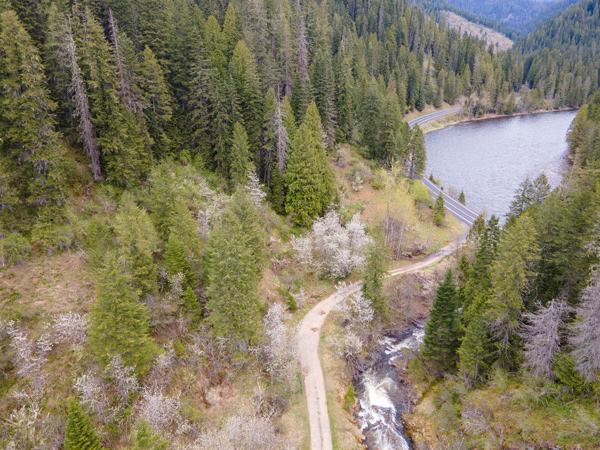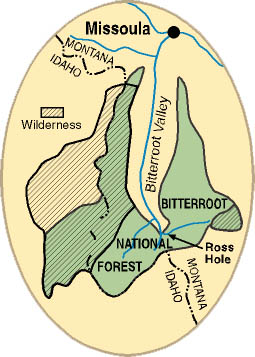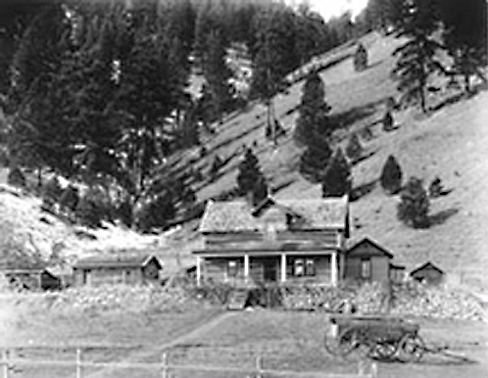Back home in Charlottesville, Virginia, in December 1806, Meriwether Lewis listened to a brief welcoming speech at a banquet in his honor. The orator spoke of the promises of “regions yet groaning under unviolated forests.” Lewis responded similarly: “With you I trust, that the discoveries we have made will not long remain unimproved.” What has happened in the forests the expedition “discovered” as they crossed the Bitterroot Divide and proceeded north down the Bitterroot Valley early on 4 September 1805?
Lochsa River at Kooskia Internment Camp
© 2021 by Kristopher K. Townsend. Permission to use granted under the Creative Commons Attribution-Share Alike 4.0 International license.
Workers at this World War II Internment Camp primarily worked on U.S. Highway 12, shown in the above photo.
Improvements
The 60-by-15-mile Bitterroot Valley, extending from a few miles north of Ross Hole all the way to Missoula, Montana, is almost entirely in private hands. The “improvement” of the valley began in the middle of the nineteenth century, centering mostly on farming, ranching, and apple-growing, and continued into the 20th century with logging of the magnificent ponderosa pine forests at the edges of the valley floor. Settlement occurred in spurts until the 1950s, then held steady for two decades. After 1970, suburban development began to mushroom.
Indeed, many residents feel that their mountain-ringed valley cannot tolerate much more “improvement” and continue to provide the quality of life that is sought and cherished. The need to develop comprehensive plans for future growth seemed obvious to some, while others staunchly resisted interference with their individual rights.
Another contentious issue has been whether U.S. highway 93 should be expanded to four lanes to speed traffic flow, or confined to a “super two” design that would discourage roadside development and limit drivers to a slower pace. The conversion to four-lane pavement alternating with super-two stretches began in the lower Bitterroot Valley in the fall of 1999. The allure of speed and the attendant illusion of diminished distances, which was just beginning to gain momentum around Lewis & Clark’s time with the invention of the steamboat and the steam locomotive, has seduced us again.
Common Resource
Climbing up and over the divide between the Salmon and Bitterroot rivers on 2 September 1805 through 4 September 1805, the journalists remarked on the”handsom tall strait” ponderosa pine trees (also called Western yellow pine), some large enough for dugout canoes, and “balsom fir”—possibly Engelmann spruce—estimated at 150 feet in height. They made their way through dense stands of subalpine fir, Douglas-fir, whitebark pine, and lodge pole pine. And what now of those “discoveries,” those “unviolated forests”?
They are now nearly all in the public domain, encompassed in an administrative unit of the U.S. Forest Service called the Bitterroot National Forest. Almost entirely surrounding the valley, it averages about 35 miles in width, and reaches roughly from the Bitterroot Divide on the south to Lolo, Montana (the site of the expedition’s Travelers’ Rest camp) on the north, a distance of about 80 miles. It contains more than 1.5 million acres within its boundaries.
Fifty-two percent of the Bitterroot National Forest is contained in the Bitterroot-Selway Wilderness, the Frank Church River of No Return Wilderness, and the Anaconda-Pintler Wilderness, where “earth and its community of life are untrammeled by man.”
An additional eighteen percent of the Forest’s acreage includes semi-primitive recreational land, wildlife preservation areas, and small ecosystems known as Resource Natural Areas. Six percent—principally the high rocky ridges of the Bitterroot Mountains—are classified as “unsuitable timberland.” A mere twenty-four percent of the entire Forest is “suitable timberland.”
Until after World War II, logging was comparatively limited, and was confined largely to the lower fringes of the valley, where the best of the yellow pine forest was cut down by the 1920s. Since 1955, however, only 35% of the entire “suitable timberland” has been subjected to logging.
During the 1960s the annual harvest reached a peak of nearly 70% of the annual estimated growth of trees in the Forest. By the 1990s it had dropped to about 10% of the annual growth. Today, even discounting an annual timber death-rate of 20%, it is clear that the forest is still growing—and dying—much faster than it is being harvested.[1]In 1975 there were four lumber mills in the Bitterroot Valley. In September 1998 Darby Lumber Inc., the last surviving mill, and one of the largest employers in the valley, laid off half its work … Continue reading
Reckoning
This huge ponderosa pine, the oldest in western Montana’s Bitterroot National Forest, and at 114 feet in height believed to be the second largest in the state, stands some distance up the West Fork of the Bitterroot River. It was perhaps 600 years old when the Corps of Discovery marched out of Ross’ Hole and down the main river valley to Travelers’ Rest. To the Salish people it was a landmark and road sign of great cultural significance for more than 500 years.
Having survived innumerable, unremembered vicissitudes, including the occasional ground-level forest fire, for eight centuries, it surrendered its spirit to a final, fatal lightening strike on 16 July 1993. Nevertheless, it was expected to remain standing for at least another hundred years, but early in the morning of 20 August 2008, it was reported ablaze from the ground up. By mid-morning the blaze had burned through the hollow trunk, and the top half fell to the ground. The cause of the much-lamented fire is still unknown.
Until the turn of the 20th century, timber on public lands throughout the country was virtually free for the taking, but by 1876 the eastern hardwood forests had all been logged over, and the great pine forests of the Lake States were going fast. Gradually the new concept of “resource conservation” began to take hold, especially under the leadership of President Theodore Roosevelt and the man he named Chief Forester, Gifford Pinchot. One outcome was the establishment of the U.S. Forest Service, under the Department of Agriculture, in 1905. After the summer of 1910, when forest fires of exceptional dimensions ravaged much of the Northern Rockies, fire suppression became a top priority of the Forest Service.
The all-out battle against both natural and man-caused fires during the past 90 years has preserved the nation’s timber resource—even increased it in volume, as we have just seen. But there have been two other consequences. With the suppression of all fires, certain kinds of trees have crowded others out, altering the distribution of species. At the same time, the accumulation of fuels—dead and diseased trees, as well as dense underbrush and unrestrained growth of trees that thrive in the shade of others—have created the conditions for fires that can burn hotter and spread faster than ever, and are thus harder to control.
Attempts to “protect” these fire-dependent forests, which have been shaped by fires for thousands of years, have resulted in practically uncontrollable wildfires, as well as infestations of insects and epidemic diseases. The fire that scorched the south slope of Saddle Mountain in 1960 was small, compared with the Sleeping Child fire of 1961, north of Ross Hole, that burned 28,000 acres. Since then, wildfires in all western forests have grown larger, hotter, and more devastating. In contrast, historical studies—one looking back to about 1540—have clearly shown that ponderosa pine forests in the Northern Rockies typically underwent small, low-intensity fires on an average of every ten years, which kept the forest floor comparatively clean.
Whatever they may have had in mind in 1806, Meriwether Lewis and his Albemarle County neighbors would be astonished at the “improvements” that actually have taken place in these “unviolated forests.” No doubt they would be overwhelmed by the complexity of the biological, ecological, sociological and political issues that have accompanied the best efforts to conserve our forest resources during the past 100 years, and with which forest managers as well as the public must reckon today.
The two photographs below serve to illustrate, in a limited way, the difference between the forests the Corps of Discovery saw, and the conditions that prevail today.
Now and Then
Wetzsteon Homestead circa 1895
Courtesy Bitterroot Valley Historical Society
This photo, taken about 1895, shows the location of the residence built a few years earlier by homesteaders Jake and May Wetzsteon at the edge of Ross Hole. The moist northeast-facing slope behind the house to the left supported a healthy stand of Douglas-fir trees. The typically open, dry and grassy, southwest-facing slope to the right supports widely-spaced ponderosa pine trees. Evidence derived from fire scars in nearby ponderosa pines suggests that this site may have been burned about once every decade for hundreds of years prior to the Wetzsteons’ arrival. No logging had ever been done here. National Forests in the Northwest are striving to re-establish ponderosa pine habitats such as this one.
Circa 1980
This view, taken in 1980, shows the result of the absence of fire and logging since 1910. It is reasonable to suppose that in 1805 this locality looked much more like the first picture than this one. Indeed, it may be said that today’s “Great American Forest” is as much a product of settlement as a victim of it.
For his painting, Lewis and Clark Meeting the Flatheads in Ross’ Hole, artist C.M. Russell made sketches from the front porch of the Wetzsteons’ home. See Ross’ Hole for the story behind this painting.
Content reviewed by: Stephen F. Arno, Intermountain Fire Sciences Laboratory; Mary Horstman, Forest Historian, Bitterroot National Forest; Stan Underwood, Sula Ranger District, Bitterroot National Forest.
Notes
| ↑1 | In 1975 there were four lumber mills in the Bitterroot Valley. In September 1998 Darby Lumber Inc., the last surviving mill, and one of the largest employers in the valley, laid off half its work force indefinitely, citing higher costs and lower income. Since 1993, industry analysts explain, the Forest Service had sold 70% less timber from its national forests, resulting in the competitive bidding-up of sawlog prices. At the same time, a recession throughout Asia greatly reduced the size of the market, which forced the price of milled lumber below the break-even point. |
|---|
Experience the Lewis and Clark Trail
The Lewis and Clark Trail Experience—our sister site at lewisandclark.travel—connects the world to people and places on the Lewis and Clark Trail.
Discover More
- The Lewis and Clark Expedition: Day by Day by Gary E. Moulton (University of Nebraska Press, 2018). The story in prose, 14 May 1804–23 September 1806.
- The Lewis and Clark Journals: An American Epic of Discovery (abridged) by Gary E. Moulton (University of Nebraska Press, 2003). Selected journal excerpts, 14 May 1804–23 September 1806.
- The Lewis and Clark Journals. by Gary E. Moulton (University of Nebraska Press, 1983–2001). The complete story in 13 volumes.






